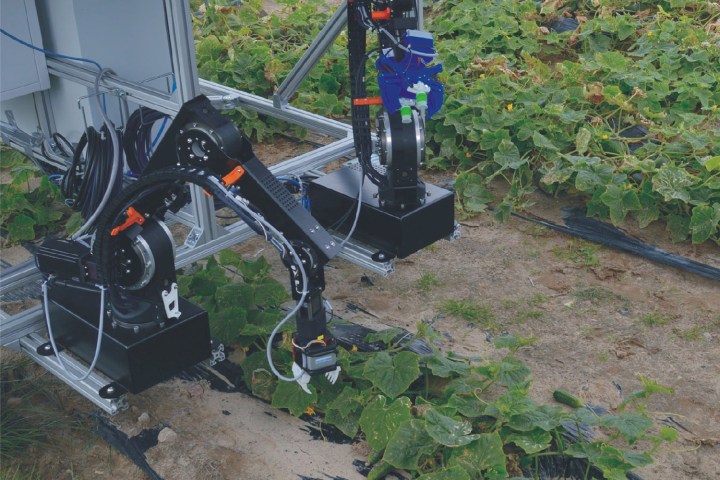Whether it’s strawberries, tomatoes, or seemingly any other type of naturally grown edible produce, specially designed “picker” robots can be devised to to pluck them from trees, bushes, the ground, or wherever else they might growing. A new project created by Germany’s Fraunhofer Institute for Production Systems and Design Technology IPK adds yet another variety of produce to the list: cucumbers.
Engineers at the Fraunhofer Institute are developing a dual-arm robot intended for the automated harvesting of cucumbers — and it could help save the backs of the human cucumber pickers who currently have to manually pick them. It’s part of an E.U. project titled CATCH, standing for (in English) “Cucumber Gathering – Green Field Experiments.”
“Automatized robotized cucumber harvesting belongs to one of more challenging tasks,” Dr. Dragoljub Surdilovic, one of the researchers on the project, told Digital Trends. “The main difficulty is to recognize and localize the green fruits in green environment, [and] to separate them without damaging or injuring the cucumber and plant. Other disturbances such as obstacles [or] moisture in a dynamic unstructured environment make the task more difficult.”
The team’s solution involves using a combination of 2D and 3D cameras, along with multispectral vision, to detect the cucumbers. This can be done with a success rate of up to 94 percent. The robotic arms support the vision systems by assisting with search through the removal of leaves in the hunt for pickles to pick. The aim is for the robot to be as efficient as an experienced human picker, who can pick as many as 13 cucumbers per minute. However, it will have the usual advantages of an automated approach: namely possible 24/7 functionality with no sick days or holidays.
It’s not quite ready for rollout in the real world, though. “We need further research and experimental evaluations,” Surdilovic said. “At first, we should improve the detection and localization of the cucumber by adding additional sensors in grippers. The separations of cucumber is a further critical problem. [The] processing industry requires exact cutting of stems without injuring the fruit and the plant. We are developing sophisticated grippers and algorithms to detect the stems using force sensing, and devices capable of following the contours of fruit to detect and cut the stems.”
Surdilovic suggested that the technology requires roughly two more years of research and development until it is mature enough for practical deployment. “A community of farmers and cucumber producers support us, showing a big interest and needs for robotic technology,” he said. “Lack of seasonal workers and relatively higher labour costs jeopardize production of cucumbers and similar cultivars, not only in German, but also globally.”
Editors' Recommendations
- Boston Dynamics retires its remarkable Atlas robot
- Guinness video celebrates robotic record-breakers
- Autonomous delivery robots at center of bomb scare ‘prank’
- Deep-diving robotic sub could be last hope for lost Titanic tourists
- Thousands of delivery robots to join Uber Eats



